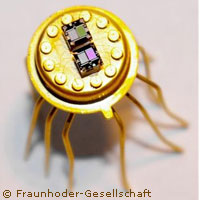Innovative technology for fresher, better food
Consumers want fresh, safe and good-quality food. But how can producers consistently meet their demands? Researchers in Germany have developed a new system based on metal-oxide sensor technology that could check food quality and safety in a quick yet cost-effective and reliable way. The researchers, from the Fraunhofer Institutes for Molecular Biology and Applied Ecology (IME) and for Physical Measurement Techniques (IPM), said their innovative system checks gasses being emitted from the food on-site, rather than in a laboratory. The system can do what lab tests can't: check quickly and cheaply. It measures volatile components to determine when fruits and vegetables are ripe, and when they're ready to go to the supermarket to be taken home for consumption. Dr Mark Bücking, head of the Department of Environmental and Food Analysis at IME, explained that the system brings together several technologies. Metal-oxide sensors, perhaps best known for their use in cars (where they can close ventilation vents when the car drives through a tunnel, for example), are central to the design. 'Researchers at IPM have developed these sensors further,' said Dr Bücking. Before the gas reaches the sensors, he explained, it passes through a separation column where irrelevant substances are filtered out. 'If a gas flows over the sensor at temperatures of 300°C to 400°C, it will burn at the point of contact,' he added. 'The subsequent exchange of electrons changes the electrical conductivity.' A prototype of the analysis equipment has been developed, and initial tests were promising. Dr Bücking speculates that the price tag for this equipment could reach the four-digit Euro mark. The cost may well be worthwhile for major suppliers: while the more versatile system's sensitivity was found to be comparable to that of conventional equipment currently used in food laboratories, it would function at a much faster pace, effectively burning fewer holes in pockets. Also, the researchers are seeking to optimise the system and adapt it to specific problems. In another development, the team is looking into whether the equipment could also be used to test pigs before they reach sexual maturity and begin to produce undesirable, odorous substances. Despite the fact that most pigs are slaughtered before sexual maturity, there is a chance that some boars could produce odorous substances prematurely. Because of this, all boars are castrated during their piglet years. This latest system could be a way out of castration for piglets: the operation may not be needed if the pork is routinely tested before it's packaged and sent to market. According to the researchers, hormones and certain odorous substances produced by male pigs play a major role in reproduction. But what female pigs find attractive doesn't (necessarily) hold true for humans.
Countries
Germany



